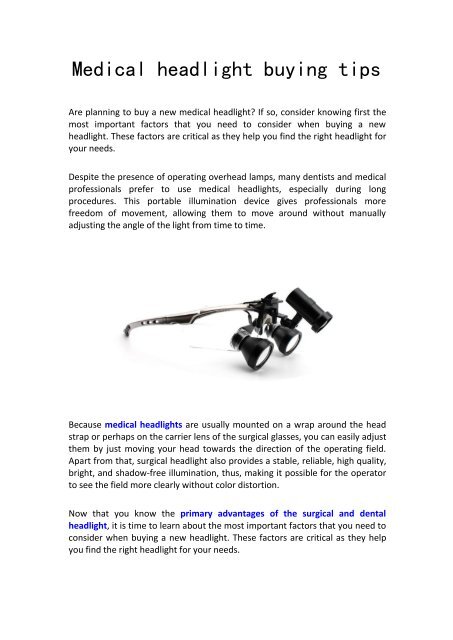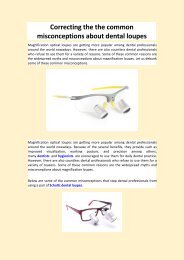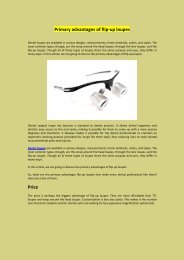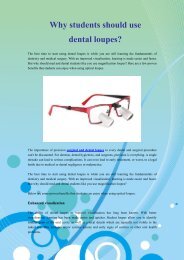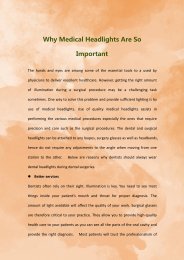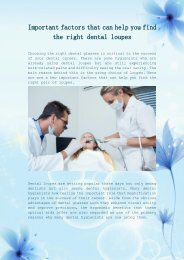Medical headlight buying tips
Because medical headlights are usually mounted on a wrap around the head strap or perhaps on the carrier lens of the surgical glasses, you can easily adjust them by just moving your head towards the direction of the operating field. Apart from that, surgical headlight also provides a stable, reliable, high quality, bright, and shadow-free illumination, thus, making it possible for the operator to see the field more clearly without color distortion.
Because medical headlights are usually mounted on a wrap around the head strap or perhaps on the carrier lens of the surgical glasses, you can easily adjust them by just moving your head towards the direction of the operating field. Apart from that, surgical headlight also provides a stable, reliable, high quality, bright, and shadow-free illumination, thus, making it possible for the operator to see the field more clearly without color distortion.
You also want an ePaper? Increase the reach of your titles
YUMPU automatically turns print PDFs into web optimized ePapers that Google loves.
<strong>Medical</strong> <strong>headlight</strong> <strong>buying</strong> <strong>tips</strong><br />
Are planning to buy a new medical <strong>headlight</strong>? If so, consider knowing first the<br />
most important factors that you need to consider when <strong>buying</strong> a new<br />
<strong>headlight</strong>. These factors are critical as they help you find the right <strong>headlight</strong> for<br />
your needs.<br />
Despite the presence of operating overhead lamps, many dentists and medical<br />
professionals prefer to use medical <strong>headlight</strong>s, especially during long<br />
procedures. This portable illumination device gives professionals more<br />
freedom of movement, allowing them to move around without manually<br />
adjusting the angle of the light from time to time.<br />
Because medical <strong>headlight</strong>s are usually mounted on a wrap around the head<br />
strap or perhaps on the carrier lens of the surgical glasses, you can easily adjust<br />
them by just moving your head towards the direction of the operating field.<br />
Apart from that, surgical <strong>headlight</strong> also provides a stable, reliable, high quality,<br />
bright, and shadow-free illumination, thus, making it possible for the operator<br />
to see the field more clearly without color distortion.<br />
Now that you know the primary advantages of the surgical and dental<br />
<strong>headlight</strong>, it is time to learn about the most important factors that you need to<br />
consider when <strong>buying</strong> a new <strong>headlight</strong>. These factors are critical as they help<br />
you find the right <strong>headlight</strong> for your needs.
Weight<br />
The <strong>headlight</strong>’s weight is something you can’t ignore most especially if you<br />
intend to use your illumination device for extended periods of time on a daily<br />
basis. If possible, pick the lightest and most portable <strong>headlight</strong> available on the<br />
market today.<br />
Please note that the longer you wear the <strong>headlight</strong>, the more it gets heavier.<br />
When the weight starts to build up over time, you will also start feeling uneasy<br />
and uncomfortable, which can greatly affect your concentration and work<br />
quality.<br />
Light Intensity Level<br />
Although it entirely depends on your personal preference, experts advice<br />
professionals to choose the <strong>headlight</strong> with a light intensity level that is over<br />
40,000 lux. For dental and surgical applications, opt for the illumination device<br />
that has a light intensity level of either 45,000 Lux or 90,000 Lux. Be careful in<br />
<strong>buying</strong> cheap <strong>headlight</strong>s as many of them have lower light intensity level or<br />
lux.
Uniformity of Light<br />
One of the major concerns when it comes to cheap <strong>headlight</strong> is the uniformity<br />
of light. The light produced by most of the cheap <strong>headlight</strong>s are unstable. The<br />
light tends to be brighter at the center but is dull on the edges. This can cause<br />
image and color distortion. For a more reliable illumination and more precise<br />
viewing field, pick the <strong>headlight</strong> that produces uniform light and stable<br />
brightness all throughout the lighted field.<br />
Brightness Control<br />
Although it is recommended to pick the surgical <strong>headlight</strong> with the maximum<br />
brightness level, it is still best to opt for the one with brightness control. This is<br />
because not all dental and surgical procedures require the same level of<br />
brightness or the same amount of light. So if a certain procedure requires only<br />
a minimum amount of light, you can still use your <strong>headlight</strong>.<br />
Beam Color<br />
Another critical factor that you should consider is the color of the beam. LED<br />
dental <strong>headlight</strong>s are available in various colors. For dental and surgical<br />
procedures, the most appropriate beam color is the one that measures 5500<br />
degrees Kelvin. This produces a pure white illumination that ensembles that of<br />
the natural daylight. Pure white LED allows you to see the real color of<br />
everything within the operating field in crisp detail without color distortion.<br />
To know the real color and the uniformity of the illumination produced by the<br />
medical <strong>headlight</strong>, turn it on and direct it to a clear wall or white plain surface.


